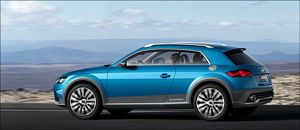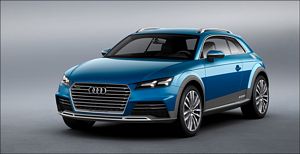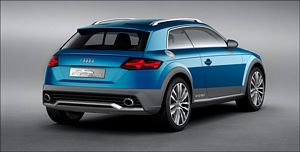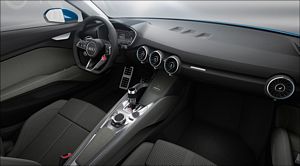|
By accessing or using The Crittenden Automotive Library™/CarsAndRacingStuff.com, you signify your agreement with the Terms of Use on our Legal Information page. Our Privacy Policy is also available there. |

Audi Design For The E-Future
|
|---|
|
|
Audi Design For The E-Future
Geoff Maxted
DriveWrite
January 12, 2014
Audi has pooled the genes of its rugged allroad models and its forthcoming e-tron hybrids to create a striking and fittingly futuristic new crossover concept bound for this month‘s 2014 North American International Auto Show in Detroit.
Incorporating a host of design elements that define the brand's future design values, the Audi allroad shooting brake combines the elegant lines of a shooting brake with the purposeful stance of an allroad. As befits an allroad-themed study, its hybrid drive - which is as powerful as it is efficient - also makes a new form of quattro drive possible - e-tron quattro.
The Company state that with exceptional functionality and versatility the Audi allroad shooting brake is geared towards those with an active lifestyle, but it also advances the development and design elements of one of the most recent Audi show cars, the mighty Sport quattro concept originally shown at the 2013 Frankfurt Motor Show. The main highlights of the show car are an aluminium and carbon fibre body shell, MatrixBeam LED headlights and the e-tron quattro drivetrain.
The outer body of the Audi allroad shooting brake is a material mix of aluminium and carbon fibre reinforced polymer (CFRP). Dark grey rubbing strips are typical allroad elements, and they visually reduce the volume of the body; they ascend dynamically from front to rear. Together with the large wheels and flared arches, they accentuate the car's off-road character.
There is plenty of room for four passengers inside. In front, the narrow sports seats give the driver and front passenger optimal body support. They feature highly contoured lateral panels and integrated head restraints, while cushioned pads support the thighs in quick driving through curves. An easy entry function makes rear seat access simpler. When the rear seatback is folded down, a cargo area with a level cargo floor is created, in which there is space for rather large sports equipment.
The cockpit is very focused on the driver. The steering wheel and digital instrument cluster lie in a single direct line of sight. The TFT display with its 12.3-inch screen presents all key information in top quality 3D graphics and offers a variety of modes. In the classic view, the power-meter for the plug-in hybrid drive system and the speedometer are in the foreground, while in Infotainment mode elements such as the large navigation map dominate, and in Sport mode the tachometer is prominently displayed. Another forward-looking feature in the show car is the Audi phone box, which links the driver's mobile phone to the vehicle electrical system and can inductively charge it as necessary.
The plug-in hybrid drive delivers impressive key performance data with 408 PS of system power and a system torque of 650 Nm (479.42 lb-ft). The show car, which weighs around 1,600 kg unladen, launches from a standstill to 62 mph in 4.6 seconds, and is capable of reaching an electronically limited top speed of 155 mph. Fuel consumption is measured at 148.7mpg according to the relevant ECE standard, which equates to CO2 emissions of 45g/km. A total driving range of up to 510 miles is achievable.
The Audi allroad shooting brake has a transverse mounted 2.0-litre four-cylinder engine with a large turbocharger. In part-load operation, indirect injection supplements direct gasoline injection to improve fuel economy; the exhaust manifold that is integrated in the cylinder head enables high-performance thermal management.
The 2.0 TFSI operates together with a disc-shaped electric motor via a decoupling clutch; the electric motor outputs 40 kW of power and 270 Nm (199.14 lb-ft) of torque. It is integrated in the six-speed e-S tronic. The ultra-fast shifting dual clutch transmission sends torque to the front wheels.
A second electric motor, which is separate from this drive unit, is mounted to the rear axle. It supplies propulsive power at low and moderate vehicle speeds with its maximum power of 85 kW and 270 Nm (199.14 lb-ft) of torque. It can also be operated in tandem with the motor and engine at the front axle if the hybrid management system decides that all-wheel drive makes sense. In such situations, for example on a slippery road or in light off-road conditions, this essentially makes the Audi allroad shooting brake an e-tron quattro.
Drive select management offers three driving modes. EV mode, which can be selected by a button on the multifunction steering wheel, prioritises all-electric driving. Here, the front drive unit is inactive, and the electric motor at the rear axle with its powerful torque can rapidly accelerate the two-door car to a top speed of 81 mph. In Hybrid mode, the drive sources operate highly efficiency, and they work together in various ways as necessary. In many situations, the electric motor in front acts as a generator - driven by the engine, it charges the battery, and this extends the car's effective electric driving range. In Sport mode, which the driver can select via the Audi drive select system, the car's full system power is available. When a high level of power is demanded by the driver, the electric motor at the rear axle works together with the 2.0 TFSI in a boost mode, in which both drive units output propulsive power.

















 Topics: Audi allroad
Topics: Audi allroad




